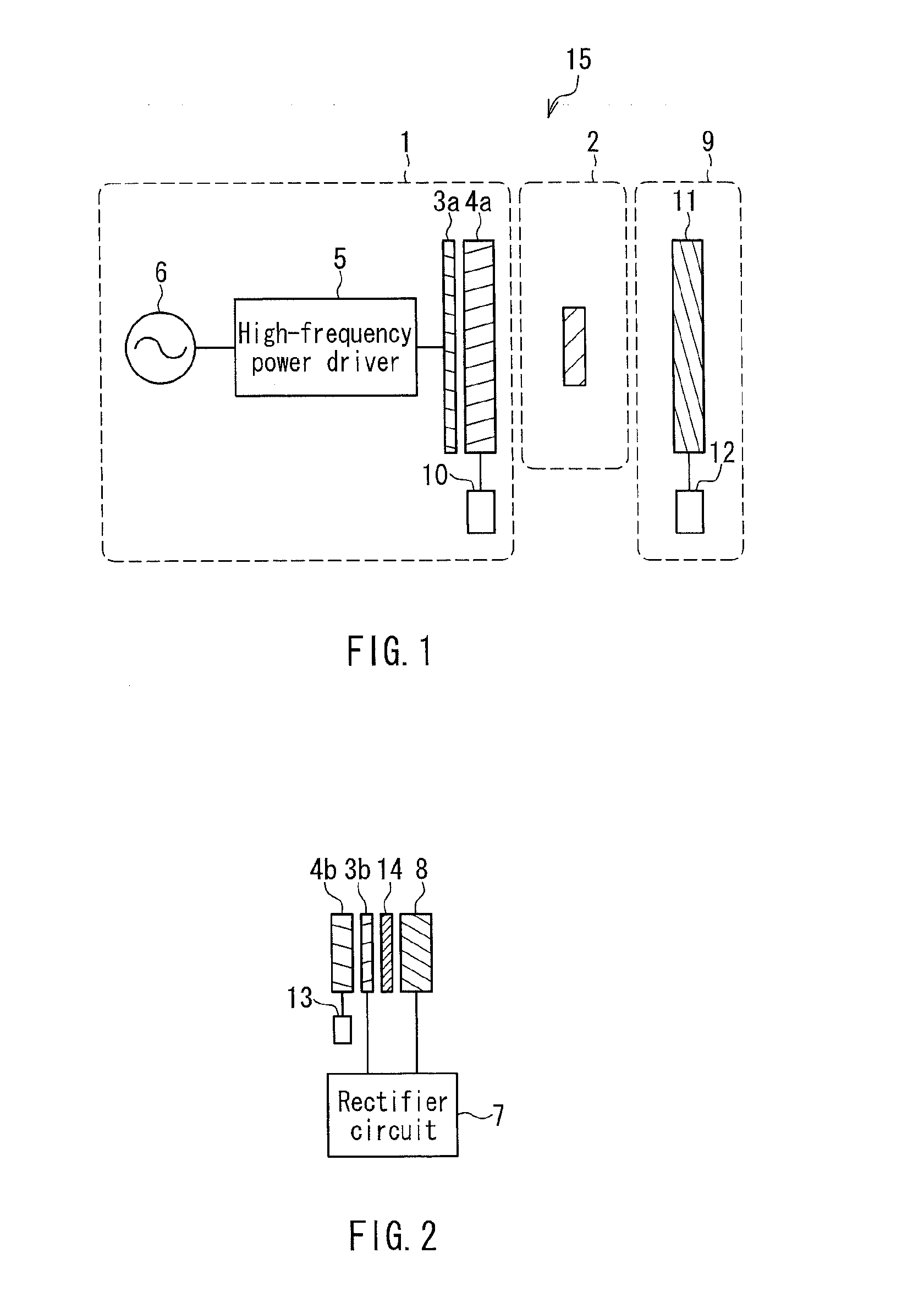Wireless power transfer device and wireless power transfer method
a power transfer device and wireless technology, applied in the direction of electric vehicle charging technology, charging stations, transportation and packaging, etc., can solve the problems of short power transmission distance, difficult power efficient transfer, and dielectric loss, so as to increase the possible power transfer distance, achieve efficient power transfer, and reduce the effect of dielectric loss
- Summary
- Abstract
- Description
- Claims
- Application Information
AI Technical Summary
Benefits of technology
Problems solved by technology
Method used
Image
Examples
embodiment 1
[0061]FIG. 1 is a cross-sectional view showing schematically the configuration of a wireless power transfer device of a magnetic field resonance type according to Embodiment 1. Note that the same elements as those of the conventional wireless power transfer device shown in FIG. 17 are denoted by the same reference numerals, and the description thereof will not be repeated.
[0062]This wireless power transfer device includes a power-transmission auxiliary device 9 in addition to the power transmitter 1 and the power receiver 2 of conventional technology, and is configured to perform wireless power transfer in a state in which the power receiver 2 is disposed in a space between the power transmitter 1 and the power-transmission auxiliary device 9. The power transmitter 1 converts power of an AC power supply (AC 100 V) into high-frequency power capable of being transmitted, and transfer the power, and the power receiver 2 receives the power. The power-transmission auxiliary device 9 has ...
embodiment 2
[0108]FIG. 15 is a cross-sectional view showing a wireless power transfer device according to Embodiment 2. This wireless power transfer device includes a vanity case-shaped (also called “music box-shaped”) casing 17 and a lid 18 that can be opened and closed, with the power transmitter 1 held in a lower interior portion of the casing 17 and the power-transmission auxiliary device 9 held by the lid 18. Provided above the power transmitter 1 is a support 19 for placing the power receiver 2, and the power receiver 2 (for example, a mobile phone or a hearing aid) can be installed onto the support 19. By closing the lid 18, the power receiver 2 is disposed between the power transmitter 1 and the power-transmission auxiliary device 9. Wireless power transfer is performed in this state.
[0109]The casing 17 is provided, for example, with a high-frequency power driver 5 that converts the power received from an AC power supply (AC 100 V) into power capable of being transmitted, and a control ...
embodiment 3
[0115]FIG. 16 is a cross-sectional view showing a wireless power transfer device according to Embodiment 3. The same elements as those of the configuration shown in FIG. 15 are denoted by the same reference numerals, and the description thereof will not be repeated.
[0116]This wireless power transfer device is an example in which a casing 24 is configured to be a vertical insertion type. More specifically, a housing portion for insertion of a mobile phone 26, which is an example of a device including the power receiver 2, is formed by a cavity portion 24a of a casing 24 and a recessed portion 25a of a lid 25, and the cavity portion 24a has a configuration that allows the mobile phone 26 to be a vertical insertion type. As in the case of Embodiment 2, the wireless power transfer device is provided with an interlock mechanism 27, and configured such that power transmission does not commence unless the lid 25 is completely closed.
[0117]With this configuration, the wireless power transfe...
PUM
| Property | Measurement | Unit |
|---|---|---|
| diameter | aaaaa | aaaaa |
| thickness | aaaaa | aaaaa |
| thickness | aaaaa | aaaaa |
Abstract
Description
Claims
Application Information
 Login to View More
Login to View More - R&D
- Intellectual Property
- Life Sciences
- Materials
- Tech Scout
- Unparalleled Data Quality
- Higher Quality Content
- 60% Fewer Hallucinations
Browse by: Latest US Patents, China's latest patents, Technical Efficacy Thesaurus, Application Domain, Technology Topic, Popular Technical Reports.
© 2025 PatSnap. All rights reserved.Legal|Privacy policy|Modern Slavery Act Transparency Statement|Sitemap|About US| Contact US: help@patsnap.com



